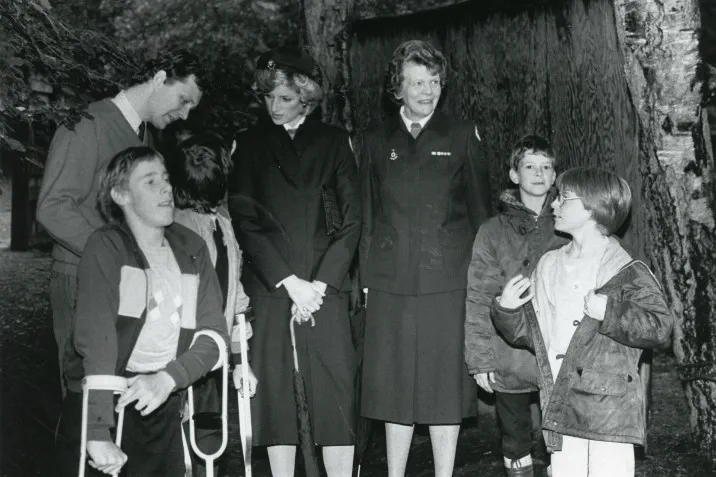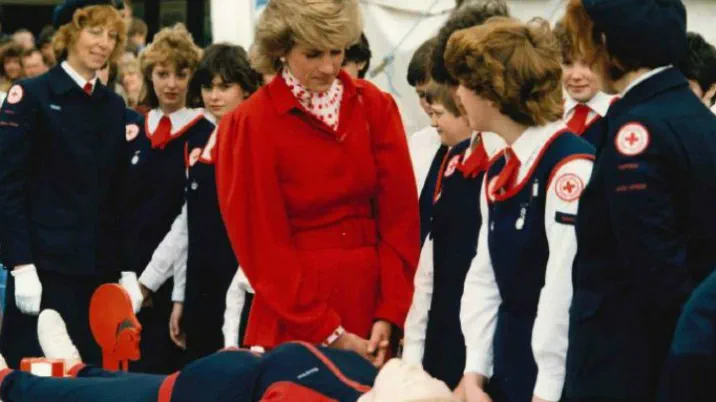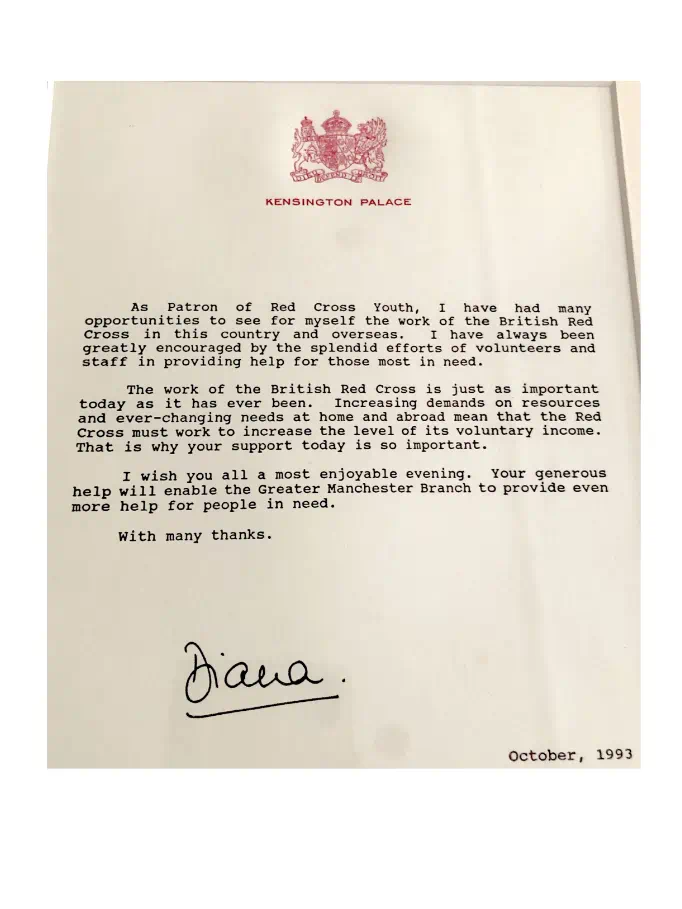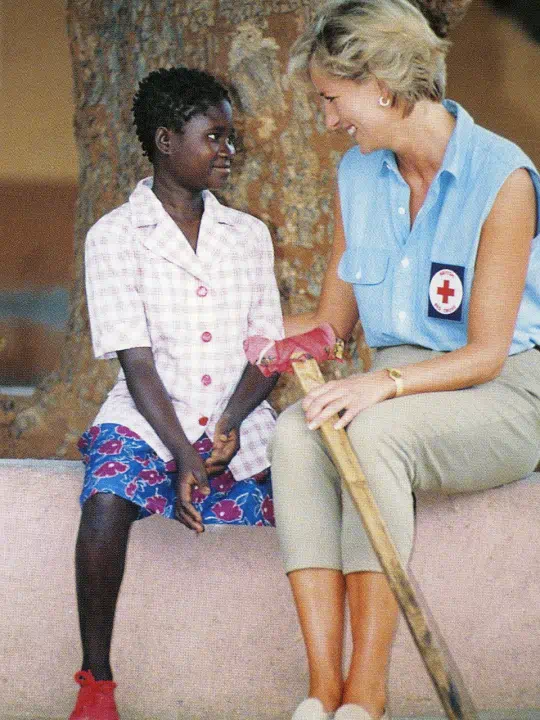Memories of Princess Diana and the British Red Cross
From discussing beans on toast to campaigning against landmines, Princess Diana was one of our most dedicated supporters
Last updated 1 July 2021
Throughout her life, Princess Diana was a dedicated humanitarian who championed causes in the UK and overseas. On what would have been her 60th birthday, 1 July 2021, we look back on her journey with the Red Cross.
Princess Diana was always committed to using her public profile to bring about positive change.
A firm believer in the power of young people, she became patron of the Red Cross Youth in 1983, which gave her an increasingly visible role with the British Red Cross.
"Diana was a real person"
In July 1985, Diana visited Activenture, a Red Cross adventure camp for children with disabilities at Hindleap Warren in East Sussex.
Barbara Summerfield, now in her 80s and from Saltdean, was a youth officer at the time and has fond memories of Diana’s visit.
“What went down well, more than anything else, was that Diana was a real person who the children could talk to,” said Barbara.

Princess Diana visiting children at Hindleep Warren in 1985
“They were very excited about her visit. I don’t think they got much sleep the night before. She watched them do their abseiling and other activities.
“They loved showing her what they could do. Some had serious disabilities and Diana was interested in their medical conditions.
THEY SPOKE TO DIANA AS A NORMAL PERSON, A FRIEND EVEN. AND THAT'S THE WAY SHE SPOKE TO THE CHILDREN.Barbara Summerfield, British Red Cross vice president, Sussex
“The children made two lovely birdhouses for Diana to give to William and Harry, but they didn’t finish them in time. When they gave them to Diana, she said: ‘Don’t worry, they [William and Harry] will finish them off.’”
Barbara, who is currently British Red Cross vice president in Sussex, added: “I thought Diana had a lovely calming manner, soothing.
“You know how when you meet a princess you bow and there are the formalities, well the children didn’t seem to worry about that. They spoke to Diana as a normal person, a friend even. And that’s the way she spoke to the children."
Listen: the day Princess Diana visited a Red Cross camp
Eileen Nicol has been involved with the British Red Cross for over 50 years and was chairman at Activenture when Princess Diana came to visit.
“Her impact was worldwide,” Eileen said. “She’s known in every country for her compassion, her smile and her love of children.
“We were so fortunate to have had her involved in our work before she sadly passed away.”
Click on the image to hear Eileen reading from her diary entry on Princess Diana's visit to Activenture.

Princess Diana observing the work of first aiders at the Suffolk Show in May 1986
"She was interested in what we did"
Edith Conn is British Red Cross president for Greater Manchester. Edith met the Princess when she visited Manchester in the mid-1980s to see a youth orchestra perform.
“We spoke about the Red Cross Youth and she was interested in what we did,” recalled Edith.
“Then we just chatted about everyday things. The funny thing about it was I said to her: ‘What happens when you go home, do you go to another engagement?’
“She said: ‘Oh no I’m going home to have beans on toast and I’m going to watch EastEnders.’ That has always stuck in my mind!”

Princess Diana's letter to Edith Conn, October 1993
"It was a real privilege to meet her"
“When she spoke to you she looked directly at you,” continued Edith. “You felt as though she was really very interested in what you did and what you had to say. She was lovely.
“I think I am very lucky to have met her. And to think back ... that we chatted about beans on toast!
“It was a real privilege to have met her and this ... should be a time to celebrate her life.”
In 1993, Diana became a vice president of the British Red Cross, and two years later she became patron of our 125th Birthday Appeal.
Edith wrote to the palace again at that time, asking for a photo to put in a Red Cross brochure promoting the annual charity ball. She received a personal and heart-warming letter back.
The Princess resigned her positions with the British Red Cross in July 1996, but continued to engage with the organisation until shortly before her death.
Princess Diana in Angola
Princess Diana took particular interest in the Red Cross’ work overseas, visiting projects in Nepal and Zimbabwe, among others.
Some of Diana’s most notable humanitarian work was around anti-personnel mines.
She famously travelled to Angola in January 1997, a trip organised and supported by the British Red Cross.
In 1995, the International Committee of the Red Cross (ICRC) launched its international ‘Landmines must be stopped’ campaign in a bid to bring about the total ban on the use of anti-personnel mines.
Angola was littered with landmines, a deadly legacy from its civil war.
Estimates put the number of landmines in the country between nine and 15 million.
Between 1979 and 1996, the ICRC fitted 9,200 amputees with false limbs in Angola, and manufactured 12,800 prostheses in total.

A lasting impact
During her time in Angola, Princess Diana visited active minefields, met local survivors of landmine violence and spoke in favour of a ban on anti-personnel mines.
After her visit, she wrote a letter to the British Red Cross saying: “If my visit has contributed in any way at all in highlighting this terrible issue, then my deepest wish will have been fulfilled.”
Diana’s visit to Angola brought unprecedented attention to the landmine issue and sparked international discussion.
The Ottawa Treaty, which placed a ban on anti-personnel mines, was signed by 122 countries in December 1997 – less than a year after Diana’s Angola visit and a few months after her death. Today, 162 UN member states are parties to the treaty.
Dr Helen Durham, director of international law and policy at the ICRC, believes Diana’s visit to Angola highlighted the problems of using anti-personnel landlines to a broader audience.
“The glamour and global appeal of Princess Diana added another layer to the voices of lawyers, humanitarian workers and medical staff who were raising their concerns about weapons that cannot distinguish between children and combatants,” said Durham.
The treaty, also known as the Mine Ban Convention, has undoubtedly saved lives. Twenty years ago, the ICRC estimated that anti-personnel landmines maimed or killed 20,000 people every year.
In 2019, that number had dropped to 5,554 casualties, according to Landmine Monitor, a report from the UN Office for the Coordination of Humanitarian Affairs.
However, due to conflicts in Afghanistan, Colombia, Iraq, Mali, Nigeria, Ukraine, and Yemen, that figure was still 60 per cent higher than in 2013, the year with the fewest casualties.
Durham added: “It is wonderful to see the progress today, but sadly we still have a long way to go to ensure that these weapons stop destroying the lives and livelihoods of thousands. Applying the Ottawa Treaty is the first step.”
Do you like what you are reading?
We have been supporting and comforting those in need across the country for 150 years. If this story has inspired you, click below to support our work and learn more about how you can help us help others.
Donate